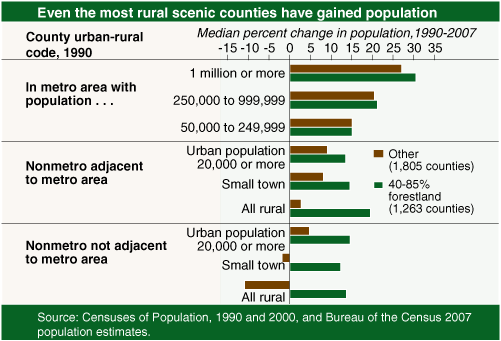Scenic Landscapes Enhance Rural Growth
- by David McGranahan
- 6/1/2009
Natural amenities play an important role in attracting and retaining people in rural America (see “Farm Programs, Natural Amenities, and Rural Development” in the February 2005 issue of Amber Waves). But what exactly are people seeking and why? Understanding why people value the rural countryside is important for gauging the costs and benefits of Federal policies that affect rural land use, including farm commodity, rural, and environmental policies.
Architectural research on landscape aesthetics has consistently found that people most prefer wooded, savannah-like settings with open vistas, clumps of trees, topographic variation, and a lake, stream, or other water source. Similarities in preferences across Asian, U.S., and European cultures have suggested to some that preferences have a genetic basis, that they reflect the habitats most suitable for early man. Other research is consistent with this conjecture. For instance, exposure to natural settings tends to reduce symptoms of stress. While not definitive, this research suggests why some families make considerable sacrifices in urban earnings and services and pay relatively high prices for rural homes (see chart) with access to the countryside.
ERS research has found that rural migration patterns are highly consistent with these findings on preferred landscapes. Topographic variation, a mix of forest and open country, and lakes or ocean water were all associated with positive rural net migration in the 1990s, and this migration led to growth in jobs. Perhaps most intriguing, counties with a mix of forest and open country tended to have substantial gains in population from 1990-2007, no matter how rural the setting. In contrast, for counties with either little or pervasive forest, the more rural the county, the more apt it was to lose population.
To illustrate the powerful effects of landscape aesthetics, consider a typical rural Iowa county whose landscape was 5 percent forest and 75 percent cropland and whose population did not grow during the 1990s. In a statistical analysis that took other county characteristics, such as industry mix and population density, into account, the results indicated that if that same county were half forest and 25 percent cropland (and otherwise unchanged), its population would have increased by nearly 8 percent over the decade.
Being rural is thought to be a disadvantage in today’s highly urban economy. But many rural communities, even those far removed from urban centers, have been growing. Landscape aesthetics appear to be highly relevant for understanding rural-area attractiveness to residents.
This article is drawn from:
- Landscape Influence on Recent Rural Migration in the U.S.. (2008). Landscape and Urban Planning. 85:3-4, pp. 228-240..
- The Importance of Natural Amenities. (2007). Handbook on Rural Households' Livelihood and Well-Being: Statistics on Rural Development and Agriculture Household Income. Annex 6, New York: United Nations..
You may also like:
- Natural Amenities Scale. (n.d.). U.S. Department of Agriculture, Economic Research Service.


